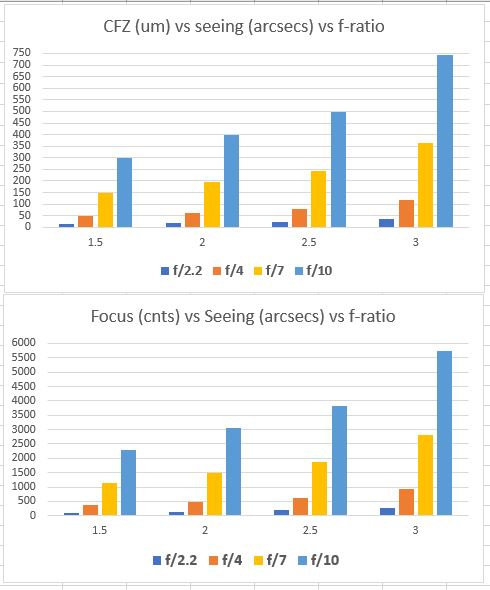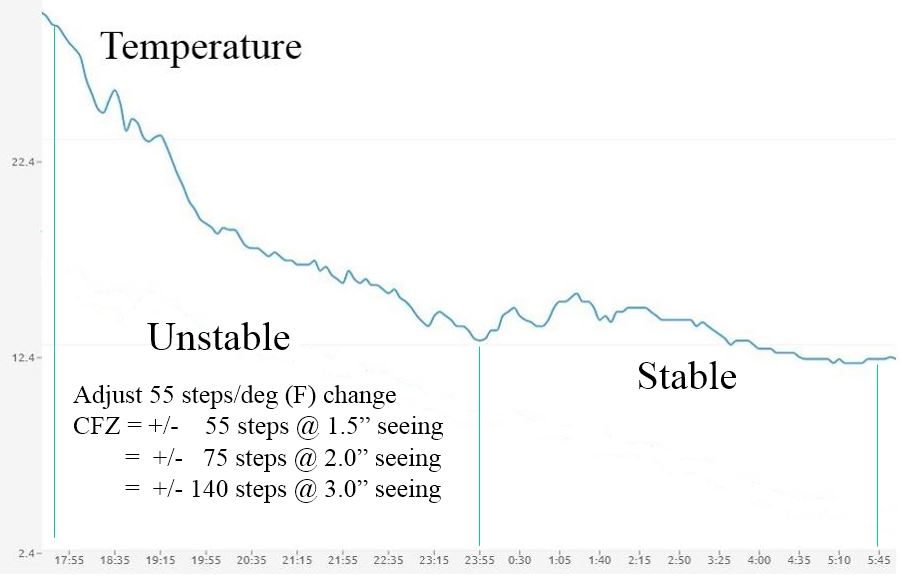INDI Library v2.0.7 is Released (01 Apr 2024)
Bi-monthly release with minor bug fixes and improvements
Temperature and Altitude (residual) focus compensation
Replied by Doug S on topic Temperature and Elevation focus compensation
This month, I used a stand-alone program to manage an autofocus "integrator", and manually offset focus between exposures as temperature and elevation changed. Manually intensive, but the results were very satisfactory! There appears to be no Ekos "gotchas" for updating focus between exposures. Adjustment can coexistent with download, dither, or exposure delay timing. I was easily able to maintain focus in my f/2.2 rig as temperatures rapidly changed. One good seeded autofocus and then occasional updates between exposures will keep focus well managed. Only 1 autofocus needed per target!
So a couple of thoughts. My 7 night January run had some bad seeing in it. Autofocus has difficulty when HFR readings are bouncing all over the place. This adds to spread in the logged data. Linear autofocus tends to pull up short of the bottom of the V curve in bad seeing, especially if the last HFR reading (averaged or not) is marginally higher than the prior HFR reading. Getting one good autofocus result (even if manually adjusted), followed by AFC updates, seems like a better approach to managing focus than risking N funky autofocus results. Finally, while I started this idea thinking that a seeded autofocus was the goal, it now seems clear that AFC between exposures IS the goal. A seeded autofocus start is desirable, but realized AFC between exposures is a "can't live without" feature for f/2 & f/3 systems! So work will continue.... cheers, Doug
Please Log in or Create an account to join the conversation.
- Peter Sütterlin
-

- Offline
- Supernova Explorer
-

- Posts: 1009
- Thank you received: 133
Replied by Peter Sütterlin on topic Temperature and Elevation focus compensation
One thing that keeps me from 'blindly' adjusting focus based on temperature is focuser backlash. How do you handle this, especially how did you measure it (assuming you do have some)? One of the reasons I do like Hys focus routine that is insensitive to (at least small) BL.
An EKOS module to automatically compute focus backlash would be a nice thing
Please Log in or Create an account to join the conversation.
Replied by Doug S on topic Temperature and Elevation focus compensation
Honestly, I'm much less worried about BL than I am with position errors introduced when linear autofocus pulls up short. That kind of error needs to be addressed. Beyond the obvious logged position error, introducing AFC would have the effect of "freezing" that bad focus (relative position offset), resulting in AFC being less ideal than if multiple sloppy AF runs were done (assuming that some of those AF solutions would be good). I need to talk to Hy offline about what these charts suggest regarding sufficient precision of linear AF solutions, and how that might lead to some improvements. More later.... Cheers, Doug
Edit: One important thing to remember about AFC is that it's operating a trendline. Generally speaking, the temperature trend will be downward (bumps excepted). This means that BL isn't a factor because the adjustments are all unidirectional. If you were really worried about BL, you could avoid adjustments during reverse bumps (they typically don't last long). Guess: the magnitude of the BL probably needs to be less than 1/2 of the CFZ to be safely ignored otherwise.
Please Log in or Create an account to join the conversation.
- Peter Sütterlin
-

- Offline
- Supernova Explorer
-

- Posts: 1009
- Thank you received: 133
Replied by Peter Sütterlin on topic Temperature and Elevation focus compensation
As for the value - I measured that with a piston micrometer (no idea if that is the proper word). The value should be fine, although I did that when the telescope was horizontal. Usually the scope will point up. I measured it from the slope of the up and down scans, so that shouldn't matter. But I have no real feeling how well that compensation works for corrections that are smaller than the BL....
As for the flex coupler: I was woried about them too, and (with my older Pegasus DMFC) did a test replacing it with a torsion-free version. It didn't affect BL. That of course depends on actual load and stick slip in the focuser gear which might be stronger at low temperatures. But for me it's indeed no issue.
Uh, you lost me there. I might have to read through this thread again...
It has improved substantially IMO. And it is insensitive to BL. Without compensation, at least for me the polynomial AF routine is close to unusable, and leads to errors larger than the position errors I get from linear. That one quite sometimes is 10 units short, very rarely 20.
Looking forward to it
Please Log in or Create an account to join the conversation.
Replied by Doug S on topic Temperature and Elevation focus compensation
About poly focus alg, we totally agree. I can't use it at all.... In that sense, the linear alg is head & shoulders above the others. I do think there's still room for improvement however, even given how much better it already is.
Please Log in or Create an account to join the conversation.
- Peter Sütterlin
-

- Offline
- Supernova Explorer
-

- Posts: 1009
- Thank you received: 133
Replied by Peter Sütterlin on topic Temperature and Elevation focus compensation
That's on a Sharpstar 140, F/6.5. So not fast at all. 1 step corresponds to 2.8μ movement, so 84 steps is 0.235mm. That is a R&P focuser, maybe it just has a coarse gear ratio.
IIRC, around 30-40 steps of that BL are internal of the EAF, based on various forum posts here and there.
Please Log in or Create an account to join the conversation.
Replied by Doug S on topic Temperature and Elevation focus compensation
Please Log in or Create an account to join the conversation.
- Peter Sütterlin
-

- Offline
- Supernova Explorer
-

- Posts: 1009
- Thank you received: 133
Replied by Peter Sütterlin on topic Temperature and Elevation focus compensation
I'm indeed not using the 10:1 fine focus. The reason is that those are friction-driven(*), and, like crayfords, are sensitive to slip. One can usually hold/fix the coarse knob on the opposite side and then turn the fine knob, and will be able to move it. I think I even read somewhere in a manual (maybe from the Pegasus? don't remember) to explicitly not use the fine gear for motor focusers.
And if the CFZ is around 50μ, a step width of 0.13μ sound like clear oversampling, isn't it?
(*) at least those that I know; they use an outer cup, an inner axis, and three steel balls as "gear". Don't know if there are others that have a real planetary gear for this.
Please Log in or Create an account to join the conversation.
Replied by Doug S on topic Temperature and Elevation focus compensation
Please Log in or Create an account to join the conversation.
Replied by Doug S on topic Temperature and Elevation focus compensation
Please Log in or Create an account to join the conversation.
Replied by Doug S on topic Temperature and Elevation focus compensation
I wanted to return to this question just for a moment (and thank you for helping me to get my BL sorted out). I've measured my BL now and set it in the INDI control. I've also verified reversal behavior is as sensitive as expected. For very short f-ratio setups, I can see that BL tuning is very important (but less important as f-ratio increases). Using the INDI BL control settings, it seems BL can be well managed. Am I missing something more important from your question?
Please Log in or Create an account to join the conversation.
- Peter Sütterlin
-

- Offline
- Supernova Explorer
-

- Posts: 1009
- Thank you received: 133
Replied by Peter Sütterlin on topic Temperature and Elevation focus compensation
Maybe just one note: Watch out for drifts in your focus position that could indicate issues from creep using the 10:1 drive.
Cheers,
Pit
Please Log in or Create an account to join the conversation.


